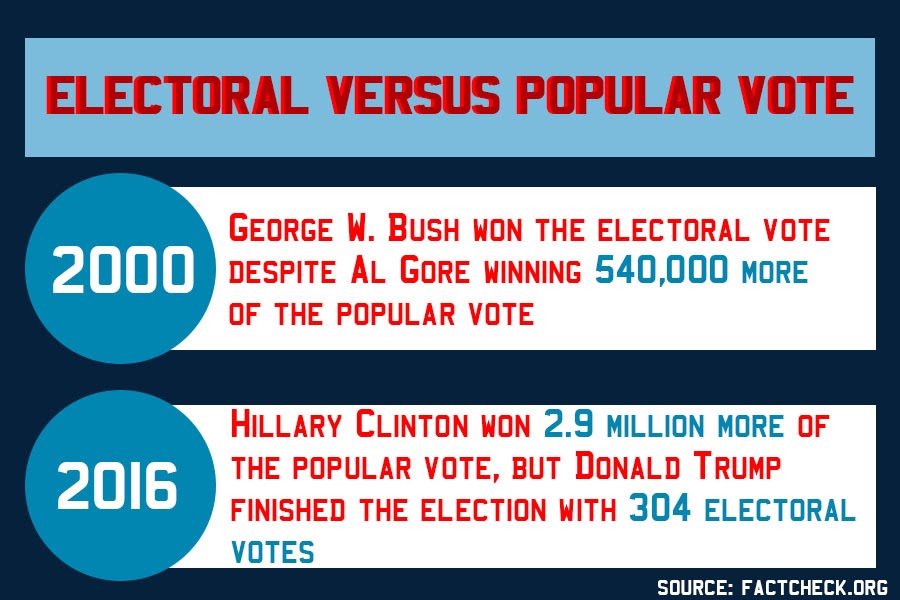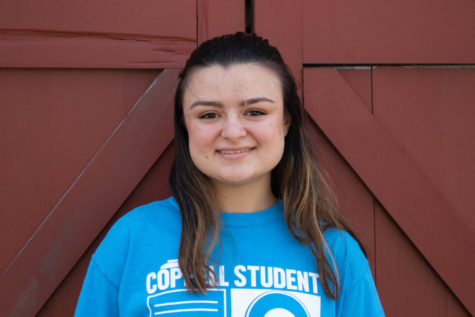Outdated voting system would be harmful in upcoming elections
Two out of the past five elections have produced a president who did not win the majority of popular votes. The Sidekick staff writer Trisha Atluri discusses a solution to the disagreement between the electoral and popular vote in recent history.
April 14, 2020
In the 2016 presidential election, Donald Trump emerged victorious as the nation’s 45th democratically elected president. However, “democratically elected” proves to be a very loose term in the modern context of the outdated voting system of the United States.
Every four years, a temporary group of electors votes for the president and vice president on behalf of the American people. Each state has the same number of electors as representatives in Congress. The first candidate to get 270 out of the total 538 electoral votes wins the race.
The Electoral College was put into place because the average American did not have access to the plethora of information we have today, which hindered their ability to make informed voting decisions. Now, we live in an acclaimed “age of information,” yet our vote hardly means anything. Bhavik Reddy, a Coppell High School senior planning on voting in the 2020 election, notes the undemocratic nature of the current system.
“Depending on the state you live in, [the Electoral College] almost renders your vote useless,” Reddy said. “If I’m in Texas or if I’m in California, and I’m voting for the minority party, my vote almost doesn’t matter to an extent because both states tilt heavily to one side. It’s going to make a lot of voters feel unmotivated about getting out and voting, which is never good in a democracy that relies heavily on a well-educated sector.”
While the uselessness of the Electoral College is widely acknowledged, one main counterargument is in order to abolish the system entirely, a new amendment would have to be passed. A new amendment requiring the support of two-thirds of the U.S. House of Representatives, two-thirds of the Senate, and three-fourths of the states.
But what if, instead of abolishing the system, we simply find a way to take advantage of it? The National Popular Vote Interstate Compact (NPVIC) does exactly that.
States signed on to the NPVIC promise to switch their electoral votes to vote for the winner of the popular vote in all 50 states and the District of Columbia. Fifteen states and the District of Columbia have joined the pact, totaling 196 electoral votes. Texas is not on this list. With 74 more electoral votes needed for the NPVIC to produce the majority, Texas can contribute 38.
Proponents of the Electoral College, such as CHS AP Government teacher Bybiana Houghton, think a system based on the popular vote would cause candidates to focus their campaigns in highly populated urban areas, completely ignoring smaller towns.
“The electoral college provides stability [and] a balance between all groups within our nation,” Houghton said. “It was created in order to provide equality among the large and the small states.”
However, recent elections have shown that equality, at least in campaigning, is yet another pitfall of the Electoral College. According to studies done by the National Popular Vote organization, 12 swing states received 96% of general election campaign events in 2012 and 2016. Political strategists had given up on the outcome in the other 38 states, causing an uneven distribution in campaign events.
“[Presidential candidates] mainly go to Wisconsin, Michigan and all the ‘battleground states,’” Coppell resident Sreekanth Palavali said. “Each person’s vote is four to 10 times more powerful than someone who lives in California or Texas or New York.”
While there have been only four instances in American history where the Electoral College disagreed with the popular vote, our increasing divisiveness makes it more important than ever that we align the two systems. As our society evolves, so should our government. In order to maximize the value of every vote and restore a true democracy, we must switch to a national popular vote.
Follow Trisha (@trishatluri) and @CHSCampusNews on Twitter.











